tow FORD MUSTANG MACH-E 2021 Owners Manual
[x] Cancel search | Manufacturer: FORD, Model Year: 2021, Model line: MUSTANG MACH-E, Model: FORD MUSTANG MACH-E 2021Pages: 460, PDF Size: 7.29 MB
Page 7 of 460
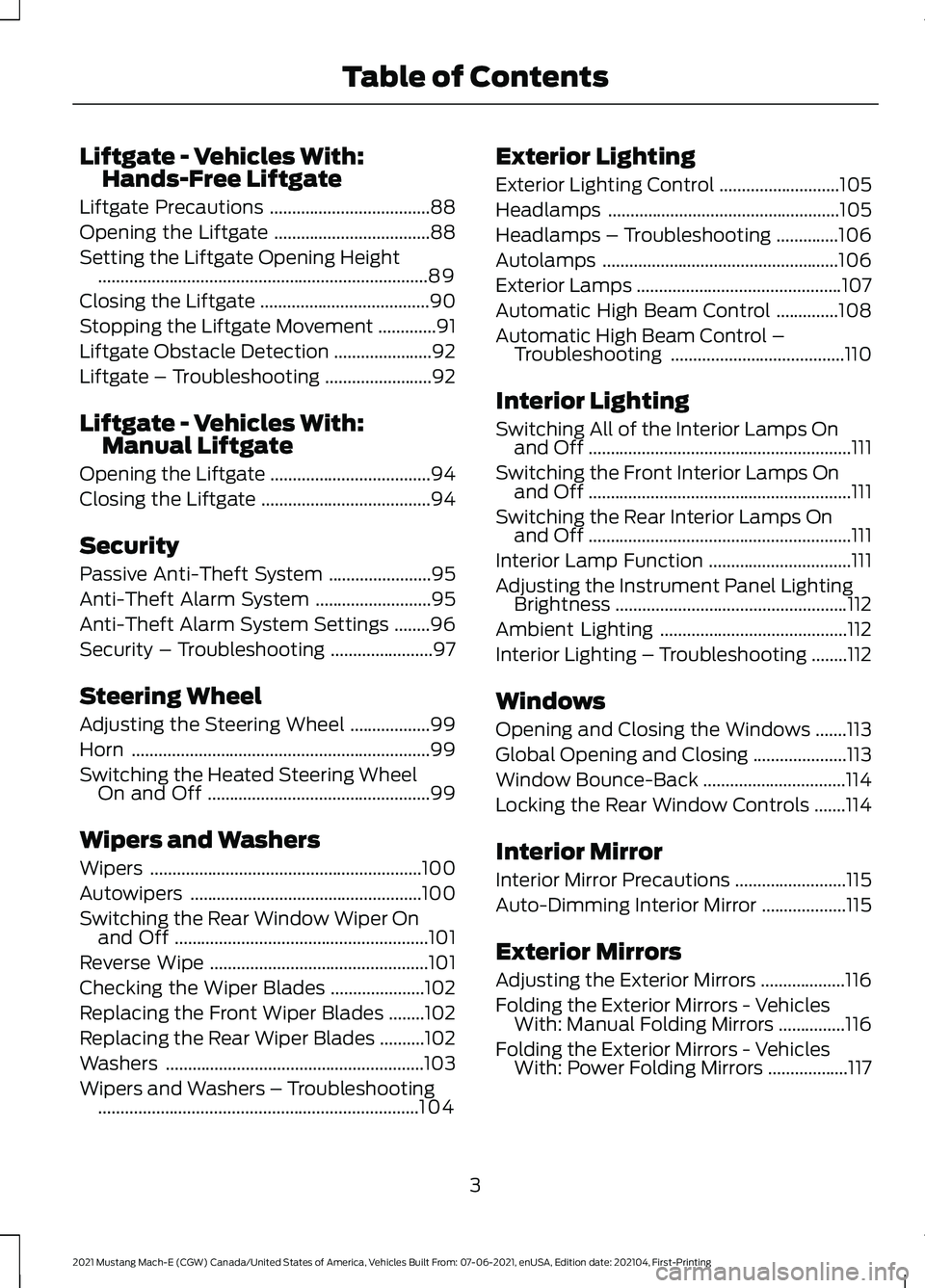
Liftgate - Vehicles With:
Hands-Free Liftgate
Liftgate Precautions ....................................88
Opening the Liftgate ...................................
88
Setting the Liftgate Opening Height ........................................................................\
..
89
Closing the Liftgate ......................................
90
Stopping the Liftgate Movement .............
91
Liftgate Obstacle Detection ......................
92
Liftgate – Troubleshooting ........................
92
Liftgate - Vehicles With: Manual Liftgate
Opening the Liftgate ....................................
94
Closing the Liftgate ......................................
94
Security
Passive Anti-Theft System .......................
95
Anti-Theft Alarm System ..........................
95
Anti-Theft Alarm System Settings ........
96
Security – Troubleshooting .......................
97
Steering Wheel
Adjusting the Steering Wheel ..................
99
Horn ...................................................................
99
Switching the Heated Steering Wheel On and Off ..................................................
99
Wipers and Washers
Wipers .............................................................
100
Autowipers ....................................................
100
Switching the Rear Window Wiper On and Off .........................................................
101
Reverse Wipe .................................................
101
Checking the Wiper Blades .....................
102
Replacing the Front Wiper Blades ........
102
Replacing the Rear Wiper Blades ..........
102
Washers ..........................................................
103
Wipers and Washers – Troubleshooting ........................................................................\
104 Exterior Lighting
Exterior Lighting Control
...........................
105
Headlamps ....................................................
105
Headlamps – Troubleshooting ..............
106
Autolamps .....................................................
106
Exterior Lamps ..............................................
107
Automatic High Beam Control ..............
108
Automatic High Beam Control – Troubleshooting .......................................
110
Interior Lighting
Switching All of the Interior Lamps On and Off ...........................................................
111
Switching the Front Interior Lamps On and Off ...........................................................
111
Switching the Rear Interior Lamps On and Off ...........................................................
111
Interior Lamp Function ................................
111
Adjusting the Instrument Panel Lighting Brightness ....................................................
112
Ambient Lighting ..........................................
112
Interior Lighting – Troubleshooting ........
112
Windows
Opening and Closing the Windows .......
113
Global Opening and Closing .....................
113
Window Bounce-Back ................................
114
Locking the Rear Window Controls .......
114
Interior Mirror
Interior Mirror Precautions .........................
115
Auto-Dimming Interior Mirror ...................
115
Exterior Mirrors
Adjusting the Exterior Mirrors ...................
116
Folding the Exterior Mirrors - Vehicles With: Manual Folding Mirrors ...............
116
Folding the Exterior Mirrors - Vehicles With: Power Folding Mirrors ..................
117
3
2021 Mustang Mach-E (CGW) Canada/United States of America, Vehicles Built From: 07-06-2021, enUSA, Edition date: 202104, First-Printing Table of Contents
Page 13 of 460
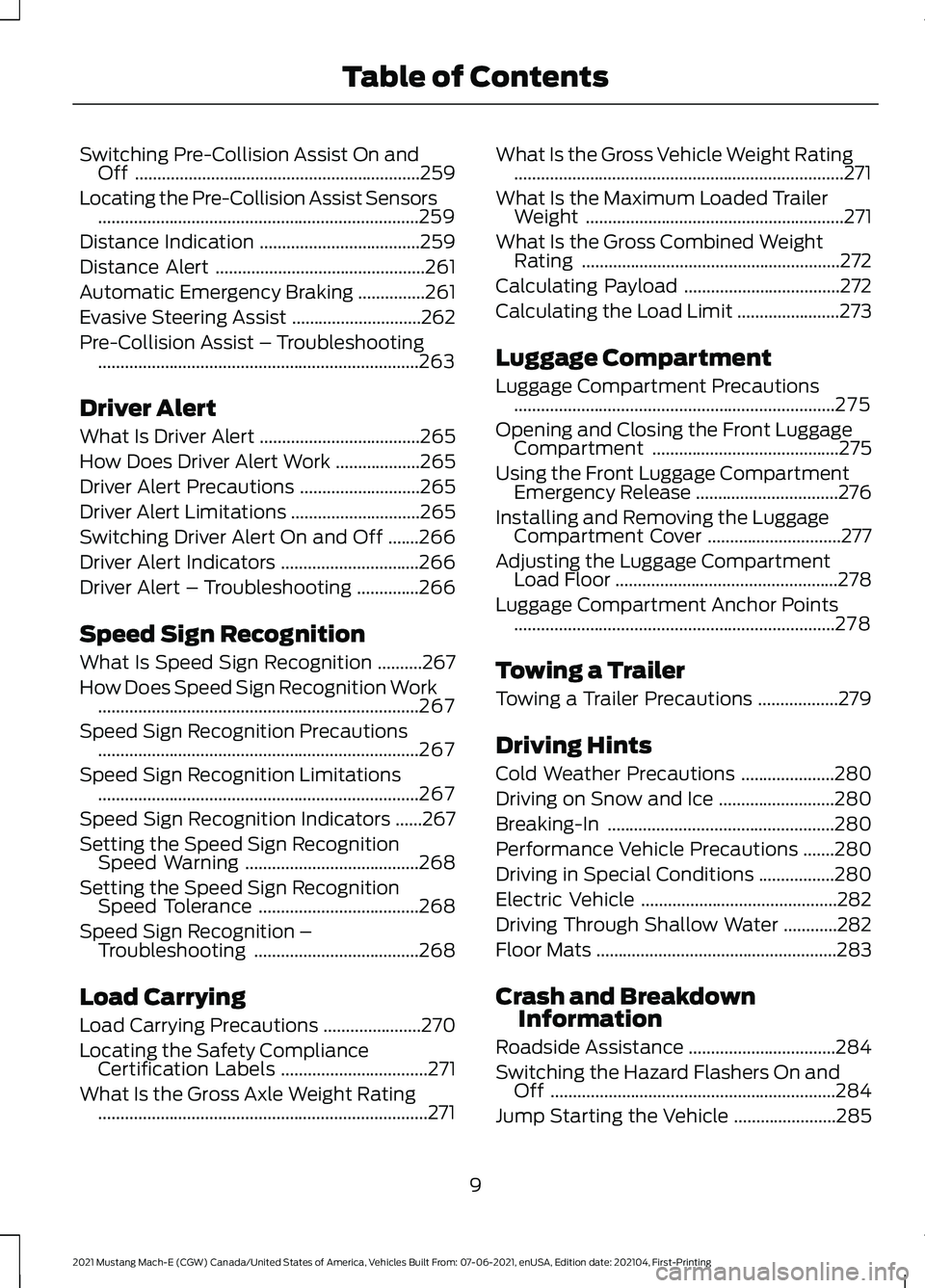
Switching Pre-Collision Assist On and
Off ................................................................259
Locating the Pre-Collision Assist Sensors ........................................................................\
259
Distance Indication ....................................
259
Distance Alert ...............................................
261
Automatic Emergency Braking ...............
261
Evasive Steering Assist .............................
262
Pre-Collision Assist – Troubleshooting ........................................................................\
263
Driver Alert
What Is Driver Alert ....................................
265
How Does Driver Alert Work ...................
265
Driver Alert Precautions ...........................
265
Driver Alert Limitations .............................
265
Switching Driver Alert On and Off .......
266
Driver Alert Indicators ...............................
266
Driver Alert – Troubleshooting ..............
266
Speed Sign Recognition
What Is Speed Sign Recognition ..........
267
How Does Speed Sign Recognition Work ........................................................................\
267
Speed Sign Recognition Precautions ........................................................................\
267
Speed Sign Recognition Limitations ........................................................................\
267
Speed Sign Recognition Indicators ......
267
Setting the Speed Sign Recognition Speed Warning .......................................
268
Setting the Speed Sign Recognition Speed Tolerance ....................................
268
Speed Sign Recognition – Troubleshooting .....................................
268
Load Carrying
Load Carrying Precautions ......................
270
Locating the Safety Compliance Certification Labels .................................
271
What Is the Gross Axle Weight Rating ........................................................................\
..
271 What Is the Gross Vehicle Weight Rating
........................................................................\
..
271
What Is the Maximum Loaded Trailer Weight ..........................................................
271
What Is the Gross Combined Weight Rating ..........................................................
272
Calculating Payload ...................................
272
Calculating the Load Limit .......................
273
Luggage Compartment
Luggage Compartment Precautions ........................................................................\
275
Opening and Closing the Front Luggage Compartment ..........................................
275
Using the Front Luggage Compartment Emergency Release ................................
276
Installing and Removing the Luggage Compartment Cover ..............................
277
Adjusting the Luggage Compartment Load Floor ..................................................
278
Luggage Compartment Anchor Points ........................................................................\
278
Towing a Trailer
Towing a Trailer Precautions ..................
279
Driving Hints
Cold Weather Precautions .....................
280
Driving on Snow and Ice ..........................
280
Breaking-In ...................................................
280
Performance Vehicle Precautions .......
280
Driving in Special Conditions .................
280
Electric Vehicle ............................................
282
Driving Through Shallow Water ............
282
Floor Mats ......................................................
283
Crash and Breakdown Information
Roadside Assistance .................................
284
Switching the Hazard Flashers On and Off ................................................................
284
Jump Starting the Vehicle .......................
285
9
2021 Mustang Mach-E (CGW) Canada/United States of America, Vehicles Built From: 07-06-2021, enUSA, Edition date: 202104, First-Printing Table of Contents
Page 14 of 460
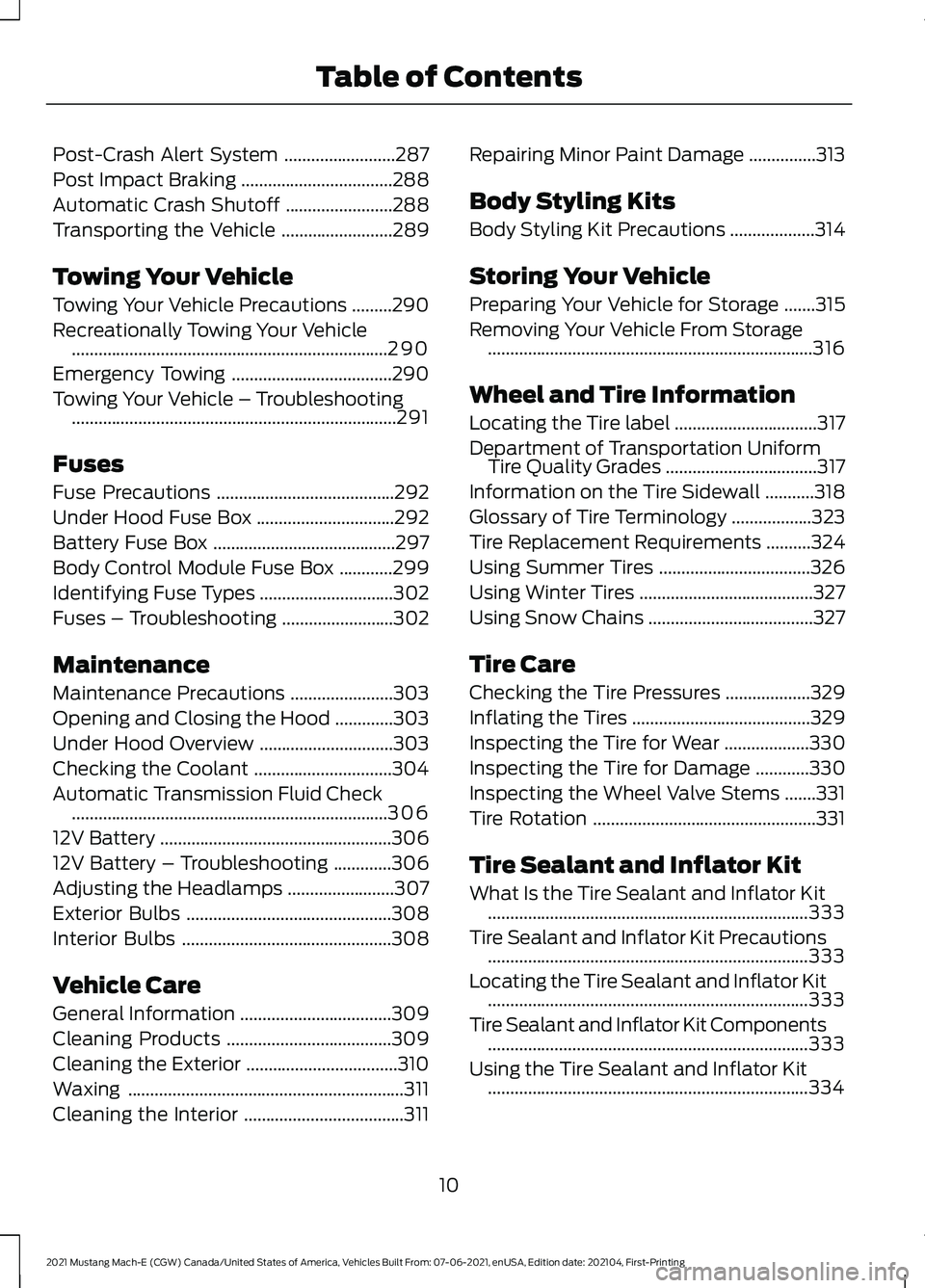
Post-Crash Alert System
.........................287
Post Impact Braking ..................................
288
Automatic Crash Shutoff ........................
288
Transporting the Vehicle .........................
289
Towing Your Vehicle
Towing Your Vehicle Precautions .........
290
Recreationally Towing Your Vehicle .......................................................................
290
Emergency Towing ....................................
290
Towing Your Vehicle – Troubleshooting ........................................................................\
.
291
Fuses
Fuse Precautions ........................................
292
Under Hood Fuse Box ...............................
292
Battery Fuse Box .........................................
297
Body Control Module Fuse Box ............
299
Identifying Fuse Types ..............................
302
Fuses – Troubleshooting .........................
302
Maintenance
Maintenance Precautions .......................
303
Opening and Closing the Hood .............
303
Under Hood Overview ..............................
303
Checking the Coolant ...............................
304
Automatic Transmission Fluid Check .......................................................................
306
12V Battery ....................................................
306
12V Battery – Troubleshooting .............
306
Adjusting the Headlamps ........................
307
Exterior Bulbs ..............................................
308
Interior Bulbs ...............................................
308
Vehicle Care
General Information ..................................
309
Cleaning Products .....................................
309
Cleaning the Exterior ..................................
310
Waxing ..............................................................
311
Cleaning the Interior ....................................
311Repairing Minor Paint Damage
...............
313
Body Styling Kits
Body Styling Kit Precautions ...................
314
Storing Your Vehicle
Preparing Your Vehicle for Storage .......
315
Removing Your Vehicle From Storage ........................................................................\
.
316
Wheel and Tire Information
Locating the Tire label ................................
317
Department of Transportation Uniform Tire Quality Grades ..................................
317
Information on the Tire Sidewall ...........
318
Glossary of Tire Terminology ..................
323
Tire Replacement Requirements ..........
324
Using Summer Tires ..................................
326
Using Winter Tires .......................................
327
Using Snow Chains .....................................
327
Tire Care
Checking the Tire Pressures ...................
329
Inflating the Tires ........................................
329
Inspecting the Tire for Wear ...................
330
Inspecting the Tire for Damage ............
330
Inspecting the Wheel Valve Stems .......
331
Tire Rotation ..................................................
331
Tire Sealant and Inflator Kit
What Is the Tire Sealant and Inflator Kit ........................................................................\
333
Tire Sealant and Inflator Kit Precautions ........................................................................\
333
Locating the Tire Sealant and Inflator Kit ........................................................................\
333
Tire Sealant and Inflator Kit Components ........................................................................\
333
Using the Tire Sealant and Inflator Kit ........................................................................\
334
10
2021 Mustang Mach-E (CGW) Canada/United States of America, Vehicles Built From: 07-06-2021, enUSA, Edition date: 202104, First-Printing Table of Contents
Page 27 of 460
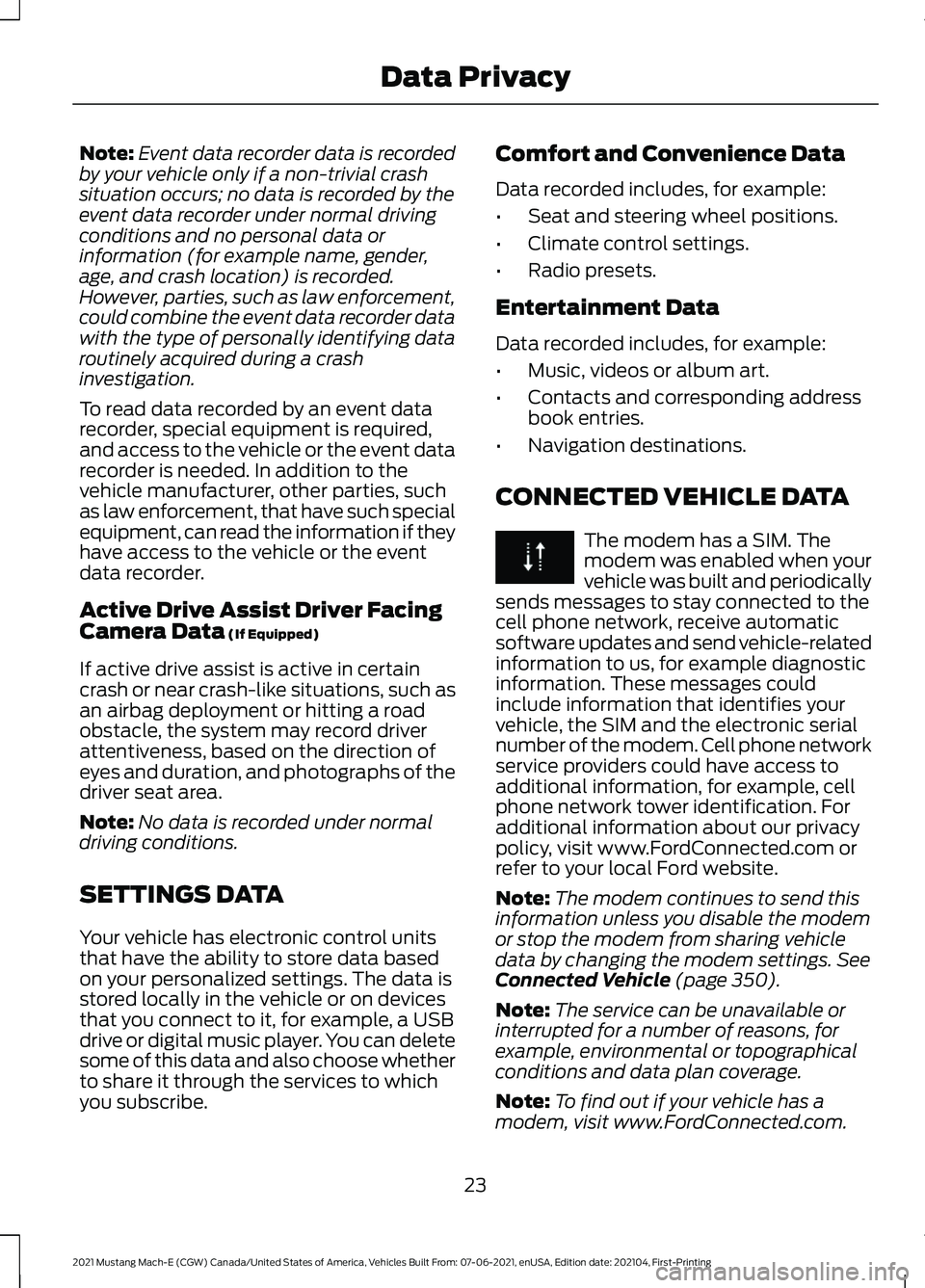
Note:
Event data recorder data is recorded
by your vehicle only if a non-trivial crash
situation occurs; no data is recorded by the
event data recorder under normal driving
conditions and no personal data or
information (for example name, gender,
age, and crash location) is recorded.
However, parties, such as law enforcement,
could combine the event data recorder data
with the type of personally identifying data
routinely acquired during a crash
investigation.
To read data recorded by an event data
recorder, special equipment is required,
and access to the vehicle or the event data
recorder is needed. In addition to the
vehicle manufacturer, other parties, such
as law enforcement, that have such special
equipment, can read the information if they
have access to the vehicle or the event
data recorder.
Active Drive Assist Driver Facing
Camera Data (If Equipped)
If active drive assist is active in certain
crash or near crash-like situations, such as
an airbag deployment or hitting a road
obstacle, the system may record driver
attentiveness, based on the direction of
eyes and duration, and photographs of the
driver seat area.
Note: No data is recorded under normal
driving conditions.
SETTINGS DATA
Your vehicle has electronic control units
that have the ability to store data based
on your personalized settings. The data is
stored locally in the vehicle or on devices
that you connect to it, for example, a USB
drive or digital music player. You can delete
some of this data and also choose whether
to share it through the services to which
you subscribe. Comfort and Convenience Data
Data recorded includes, for example:
•
Seat and steering wheel positions.
• Climate control settings.
• Radio presets.
Entertainment Data
Data recorded includes, for example:
• Music, videos or album art.
• Contacts and corresponding address
book entries.
• Navigation destinations.
CONNECTED VEHICLE DATA The modem has a SIM. The
modem was enabled when your
vehicle was built and periodically
sends messages to stay connected to the
cell phone network, receive automatic
software updates and send vehicle-related
information to us, for example diagnostic
information. These messages could
include information that identifies your
vehicle, the SIM and the electronic serial
number of the modem. Cell phone network
service providers could have access to
additional information, for example, cell
phone network tower identification. For
additional information about our privacy
policy, visit www.FordConnected.com or
refer to your local Ford website.
Note: The modem continues to send this
information unless you disable the modem
or stop the modem from sharing vehicle
data by changing the modem settings.
See
Connected Vehicle (page 350).
Note: The service can be unavailable or
interrupted for a number of reasons, for
example, environmental or topographical
conditions and data plan coverage.
Note: To find out if your vehicle has a
modem, visit www.FordConnected.com.
23
2021 Mustang Mach-E (CGW) Canada/United States of America, Vehicles Built From: 07-06-2021, enUSA, Edition date: 202104, First-Printing Data Privacy
Page 40 of 460
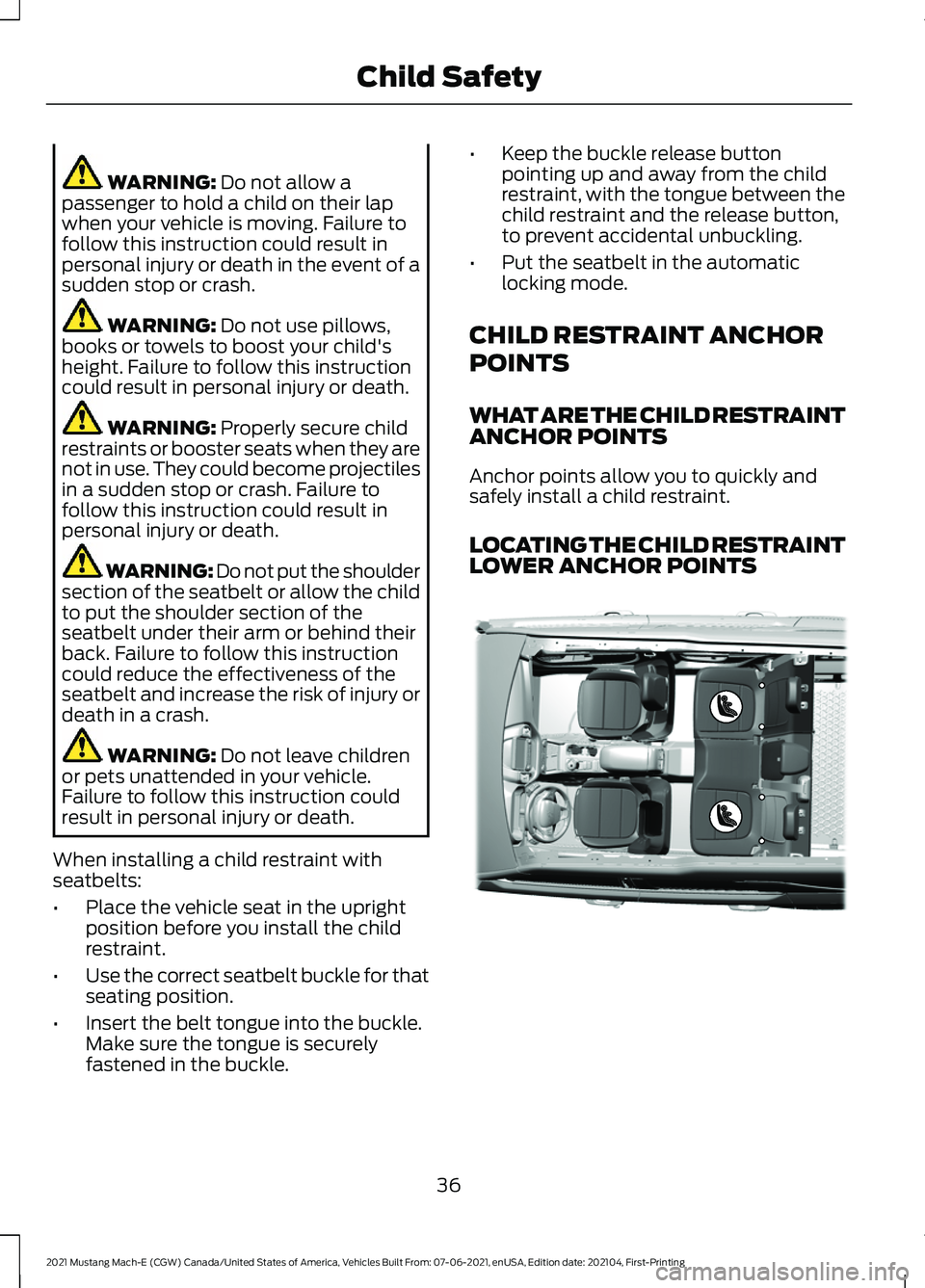
WARNING: Do not allow a
passenger to hold a child on their lap
when your vehicle is moving. Failure to
follow this instruction could result in
personal injury or death in the event of a
sudden stop or crash. WARNING:
Do not use pillows,
books or towels to boost your child's
height. Failure to follow this instruction
could result in personal injury or death. WARNING:
Properly secure child
restraints or booster seats when they are
not in use. They could become projectiles
in a sudden stop or crash. Failure to
follow this instruction could result in
personal injury or death. WARNING: Do not put the shoulder
section of the seatbelt or allow the child
to put the shoulder section of the
seatbelt under their arm or behind their
back. Failure to follow this instruction
could reduce the effectiveness of the
seatbelt and increase the risk of injury or
death in a crash. WARNING:
Do not leave children
or pets unattended in your vehicle.
Failure to follow this instruction could
result in personal injury or death.
When installing a child restraint with
seatbelts:
• Place the vehicle seat in the upright
position before you install the child
restraint.
• Use the correct seatbelt buckle for that
seating position.
• Insert the belt tongue into the buckle.
Make sure the tongue is securely
fastened in the buckle. •
Keep the buckle release button
pointing up and away from the child
restraint, with the tongue between the
child restraint and the release button,
to prevent accidental unbuckling.
• Put the seatbelt in the automatic
locking mode.
CHILD RESTRAINT ANCHOR
POINTS
WHAT ARE THE CHILD RESTRAINT
ANCHOR POINTS
Anchor points allow you to quickly and
safely install a child restraint.
LOCATING THE CHILD RESTRAINT
LOWER ANCHOR POINTS 36
2021 Mustang Mach-E (CGW) Canada/United States of America, Vehicles Built From: 07-06-2021, enUSA, Edition date: 202104, First-Printing Child SafetyE316405
Page 44 of 460

7.
Pull the seatbelt out of the retractor to
make sure the retractor is in the
automatic locking mode. You should
not be able to pull more belt out. If the
retractor is not locked, unbuckle the
belt and repeat Steps 5 and 6. 8.
Remove remaining slack from the belt.
Force the seat down with extra weight,
for example, by pressing down or
kneeling on the child restraint while
pulling up on the shoulder belt in order
to force slack from the belt. This is
necessary to remove the remaining
slack that exists once you add the extra
weight of the child to the child restraint.
It also helps to achieve the proper
snugness of the child restraint to your
vehicle. Sometimes, a slight lean
toward the buckle helps to remove
remaining slack from the belt.
9. If the child restraint has a tether strap, attach it. 10. Before placing the child in the seat,
forcibly move the seat forward and
back to make sure the seat is securely
held in place.
To check this, grab the seat at the belt path
and attempt to move it side to side and
forward and back. There should be no
more than 1 in (2.5 cm) of movement.
We recommend checking with a NHTSA
Certified Child Passenger Safety
Technician to make certain the child
restraint is properly installed. In Canada,
check with Transport Canada for referral
to a Child Car Seat Clinic.
USING LOWER ANCHORS AND
TETHERS FOR CHILDREN WARNING: Do not attach two child
safety restraints to the same anchor. In
a crash, one anchor may not be strong
enough to hold two child safety restraint
attachments and may break, causing
serious injury or death.
40
2021 Mustang Mach-E (CGW) Canada/United States of America, Vehicles Built From: 07-06-2021, enUSA, Edition date: 202104, First-Printing Child SafetyE142533 E142534
Page 51 of 460
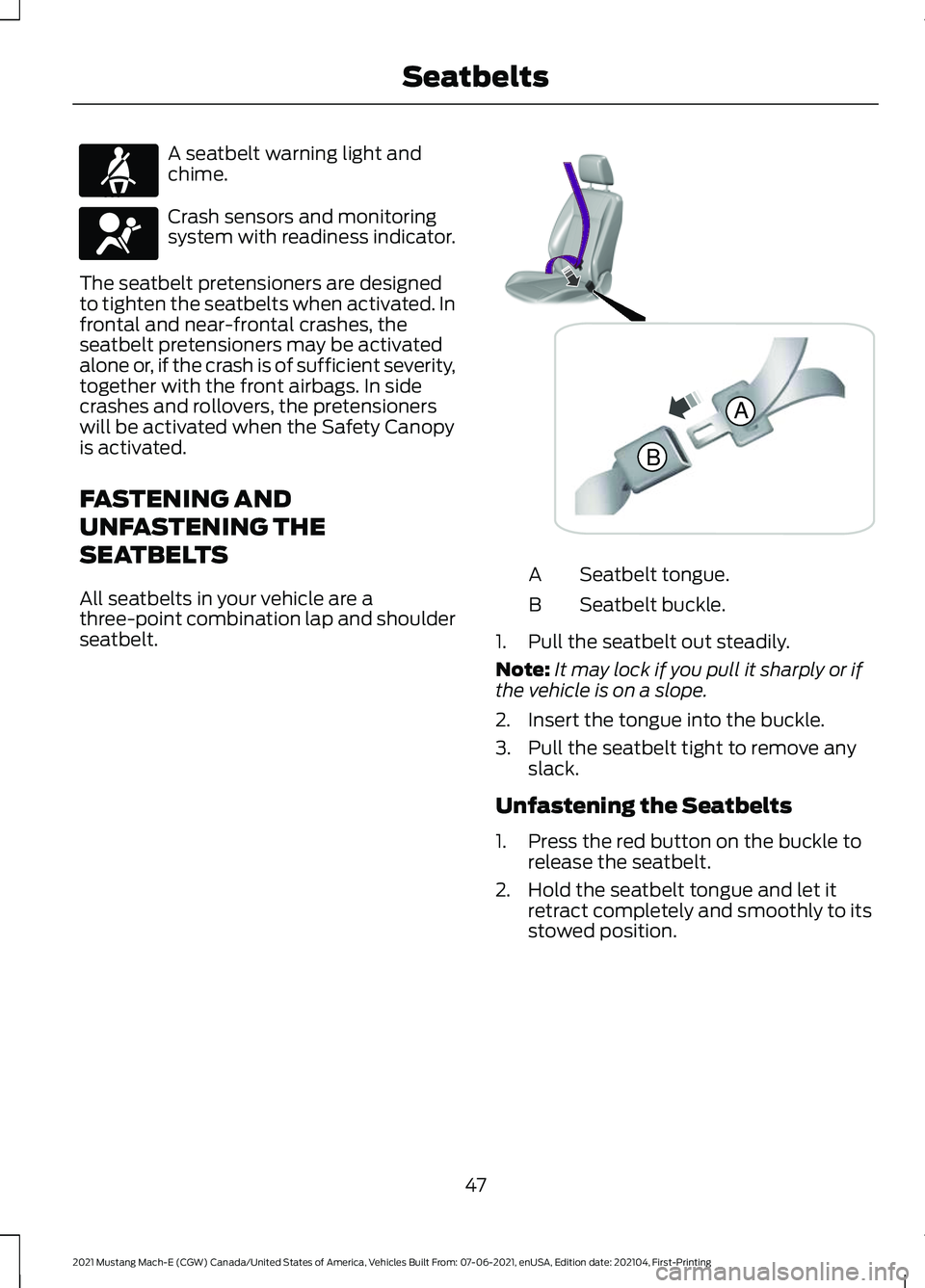
A seatbelt warning light and
chime.
Crash sensors and monitoring
system with readiness indicator.
The seatbelt pretensioners are designed
to tighten the seatbelts when activated. In
frontal and near-frontal crashes, the
seatbelt pretensioners may be activated
alone or, if the crash is of sufficient severity,
together with the front airbags. In side
crashes and rollovers, the pretensioners
will be activated when the Safety Canopy
is activated.
FASTENING AND
UNFASTENING THE
SEATBELTS
All seatbelts in your vehicle are a
three-point combination lap and shoulder
seatbelt. Seatbelt tongue.
A
Seatbelt buckle.
B
1. Pull the seatbelt out steadily.
Note: It may lock if you pull it sharply or if
the vehicle is on a slope.
2. Insert the tongue into the buckle.
3. Pull the seatbelt tight to remove any slack.
Unfastening the Seatbelts
1. Press the red button on the buckle to release the seatbelt.
2. Hold the seatbelt tongue and let it retract completely and smoothly to its
stowed position.
47
2021 Mustang Mach-E (CGW) Canada/United States of America, Vehicles Built From: 07-06-2021, enUSA, Edition date: 202104, First-Printing SeatbeltsE71880 E67017 B
A E338014
Page 52 of 460
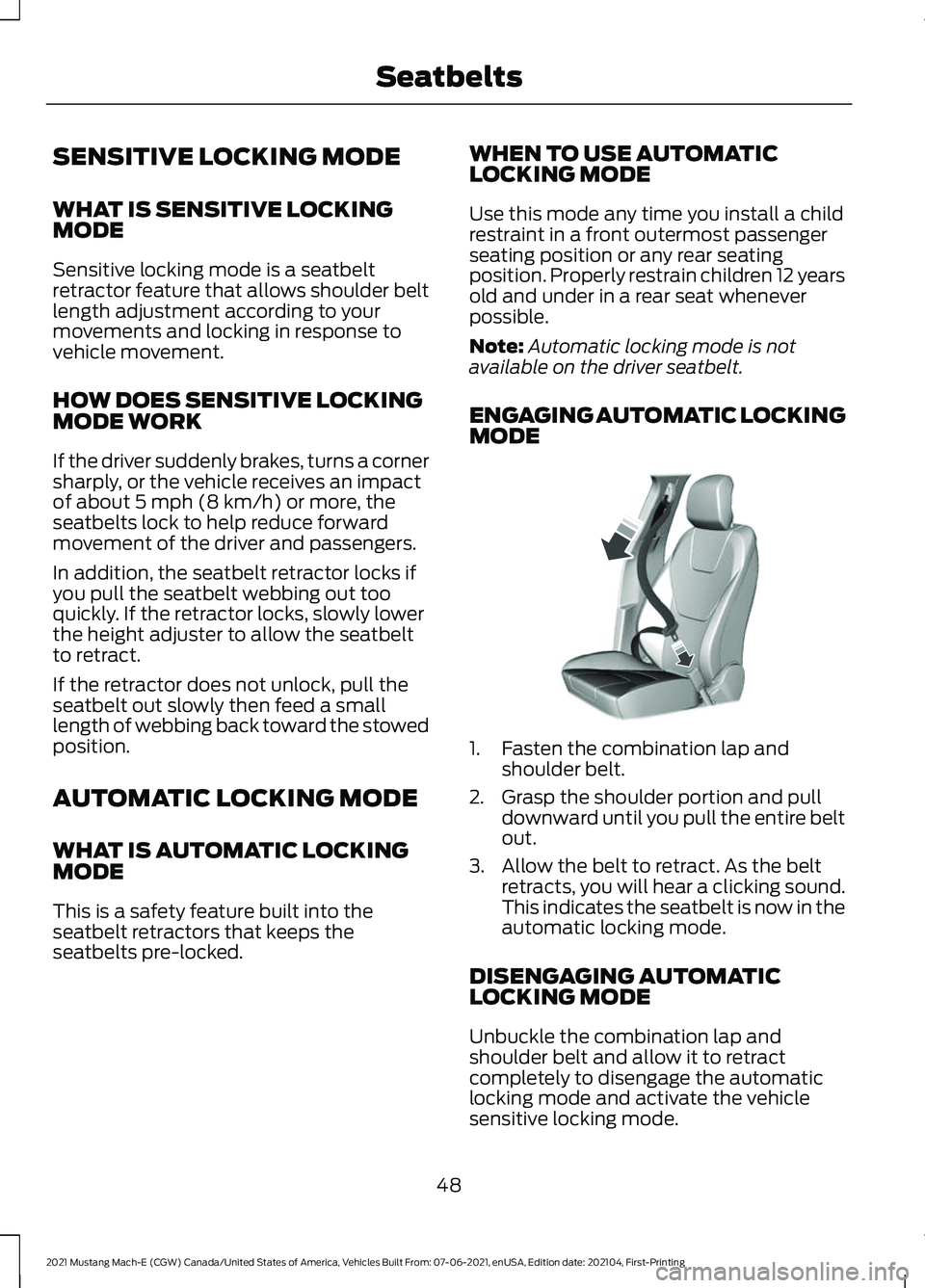
SENSITIVE LOCKING MODE
WHAT IS SENSITIVE LOCKING
MODE
Sensitive locking mode is a seatbelt
retractor feature that allows shoulder belt
length adjustment according to your
movements and locking in response to
vehicle movement.
HOW DOES SENSITIVE LOCKING
MODE WORK
If the driver suddenly brakes, turns a corner
sharply, or the vehicle receives an impact
of about 5 mph (8 km/h) or more, the
seatbelts lock to help reduce forward
movement of the driver and passengers.
In addition, the seatbelt retractor locks if
you pull the seatbelt webbing out too
quickly. If the retractor locks, slowly lower
the height adjuster to allow the seatbelt
to retract.
If the retractor does not unlock, pull the
seatbelt out slowly then feed a small
length of webbing back toward the stowed
position.
AUTOMATIC LOCKING MODE
WHAT IS AUTOMATIC LOCKING
MODE
This is a safety feature built into the
seatbelt retractors that keeps the
seatbelts pre-locked. WHEN TO USE AUTOMATIC
LOCKING MODE
Use this mode any time you install a child
restraint in a front outermost passenger
seating position or any rear seating
position. Properly restrain children 12 years
old and under in a rear seat whenever
possible.
Note:
Automatic locking mode is not
available on the driver seatbelt.
ENGAGING AUTOMATIC LOCKING
MODE 1. Fasten the combination lap and
shoulder belt.
2. Grasp the shoulder portion and pull downward until you pull the entire belt
out.
3. Allow the belt to retract. As the belt retracts, you will hear a clicking sound.
This indicates the seatbelt is now in the
automatic locking mode.
DISENGAGING AUTOMATIC
LOCKING MODE
Unbuckle the combination lap and
shoulder belt and allow it to retract
completely to disengage the automatic
locking mode and activate the vehicle
sensitive locking mode.
48
2021 Mustang Mach-E (CGW) Canada/United States of America, Vehicles Built From: 07-06-2021, enUSA, Edition date: 202104, First-Printing SeatbeltsE142591
Page 63 of 460
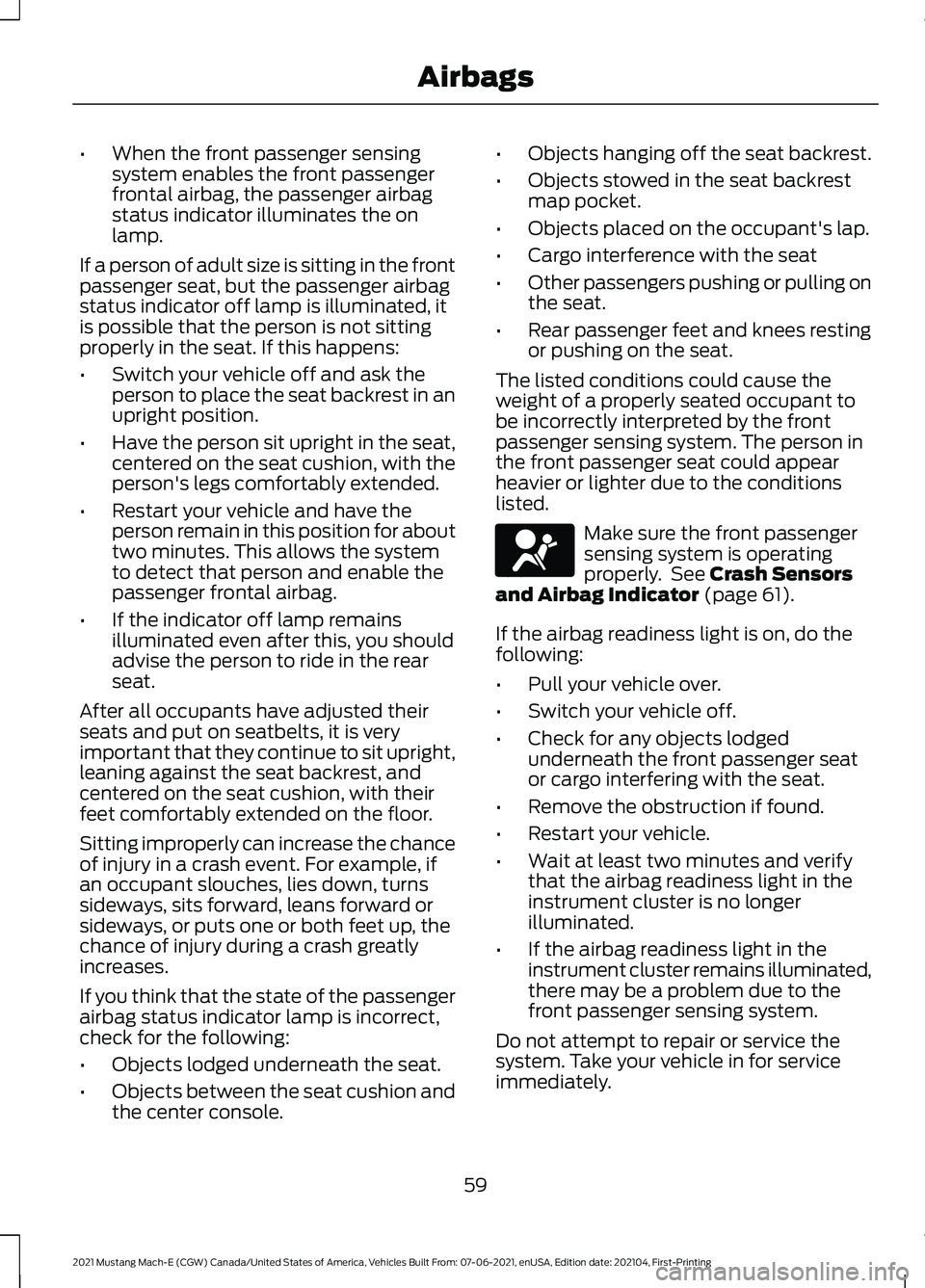
•
When the front passenger sensing
system enables the front passenger
frontal airbag, the passenger airbag
status indicator illuminates the on
lamp.
If a person of adult size is sitting in the front
passenger seat, but the passenger airbag
status indicator off lamp is illuminated, it
is possible that the person is not sitting
properly in the seat. If this happens:
• Switch your vehicle off and ask the
person to place the seat backrest in an
upright position.
• Have the person sit upright in the seat,
centered on the seat cushion, with the
person's legs comfortably extended.
• Restart your vehicle and have the
person remain in this position for about
two minutes. This allows the system
to detect that person and enable the
passenger frontal airbag.
• If the indicator off lamp remains
illuminated even after this, you should
advise the person to ride in the rear
seat.
After all occupants have adjusted their
seats and put on seatbelts, it is very
important that they continue to sit upright,
leaning against the seat backrest, and
centered on the seat cushion, with their
feet comfortably extended on the floor.
Sitting improperly can increase the chance
of injury in a crash event. For example, if
an occupant slouches, lies down, turns
sideways, sits forward, leans forward or
sideways, or puts one or both feet up, the
chance of injury during a crash greatly
increases.
If you think that the state of the passenger
airbag status indicator lamp is incorrect,
check for the following:
• Objects lodged underneath the seat.
• Objects between the seat cushion and
the center console. •
Objects hanging off the seat backrest.
• Objects stowed in the seat backrest
map pocket.
• Objects placed on the occupant's lap.
• Cargo interference with the seat
• Other passengers pushing or pulling on
the seat.
• Rear passenger feet and knees resting
or pushing on the seat.
The listed conditions could cause the
weight of a properly seated occupant to
be incorrectly interpreted by the front
passenger sensing system. The person in
the front passenger seat could appear
heavier or lighter due to the conditions
listed. Make sure the front passenger
sensing system is operating
properly. See Crash Sensors
and Airbag Indicator (page 61).
If the airbag readiness light is on, do the
following:
• Pull your vehicle over.
• Switch your vehicle off.
• Check for any objects lodged
underneath the front passenger seat
or cargo interfering with the seat.
• Remove the obstruction if found.
• Restart your vehicle.
• Wait at least two minutes and verify
that the airbag readiness light in the
instrument cluster is no longer
illuminated.
• If the airbag readiness light in the
instrument cluster remains illuminated,
there may be a problem due to the
front passenger sensing system.
Do not attempt to repair or service the
system. Take your vehicle in for service
immediately.
59
2021 Mustang Mach-E (CGW) Canada/United States of America, Vehicles Built From: 07-06-2021, enUSA, Edition date: 202104, First-Printing AirbagsE67017
Page 65 of 460

CRASH SENSORS AND
AIRBAG INDICATOR
WARNING: Modifying or adding
equipment to the front end of your
vehicle (including hood, bumper system,
frame, front end body structure, tow
hooks and hood pins) may affect the
performance of the airbag system,
increasing the risk of injury. Do not
modify or add equipment to the front
end of your vehicle.
Your vehicle has a collection of crash and
occupant sensors. These sensors provide
information to the restraints control
module which activates the following:
• Front and rear seatbelt pretensioners.
• Driver airbag.
• Passenger airbag.
• Knee airbag(s).
• Front and rear seat mounted side
airbags.
• Adaptive steering column.
• Side curtain airbags.
Based on the type of crash, the restraints
control module deploys the appropriate
safety devices.
The restraints control module also
monitors the readiness of the above safety
devices plus the crash and occupant
sensors. The readiness of the safety
system is indicated by a warning indicator
light in the instrument cluster or by a
backup tone if the warning light is not
working. Routine maintenance of the
airbag is not required.
A difficulty with the system is indicated by
one or more of the following: The readiness light will not
illuminate immediately after you
switch the power on. •
The readiness light either flashes or
stays on.
• You hear a series of five tones. The
tone pattern repeats periodically until
the problem, the light or both are
repaired.
If any of these things happen, even
intermittently, have the supplemental
restraint system serviced immediately.
Unless serviced, the system may not
function properly in the event of a crash.
The fact that the seatbelt pretensioners
or front airbags did not activate for both
front seat occupants in a crash does not
mean that something is wrong with the
system. Rather, it means the restraints
control module determined the accident
conditions (crash severity, seatbelt usage)
were not appropriate to activate these
safety devices.
• The front airbags activate only in
frontal and near-frontal crashes. Front
airbags may activate in rollovers, side
impacts or rear impacts if the crash
causes sufficient frontal deceleration.
• The seatbelt pretensioners activate in
frontal, near-frontal and side crashes,
and in rollovers.
• The knee airbag deploys based on
crash severity and occupant conditions.
• The side airbags inflate in certain side
impact crashes or rollover events. Side
airbags may activate in other types of
crashes if the vehicle experiences
sufficient sideways motion or
deformation.
• The Safety Canopy inflates in certain
side impact crashes or rollover events.
The Safety Canopy may activate in
other types of crashes if the vehicle
experiences sufficient sideways motion
or deformation, or a certain likelihood
of rollover.
61
2021 Mustang Mach-E (CGW) Canada/United States of America, Vehicles Built From: 07-06-2021, enUSA, Edition date: 202104, First-Printing AirbagsE67017